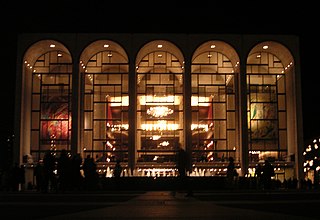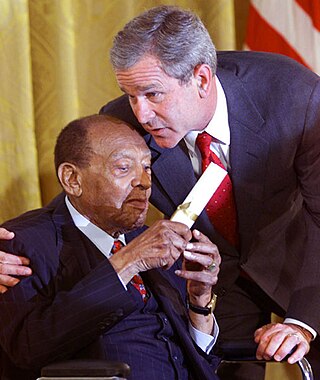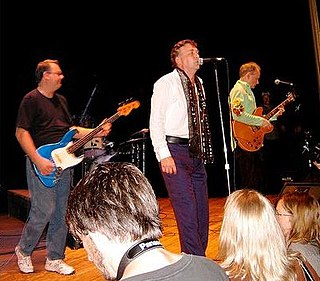
Kansas is a landlocked state in the Midwestern region of the United States. It borders Nebraska to the north; Missouri to the east; Oklahoma to the south; and Colorado to the west. Kansas is named after the Kansas River, in turn named after the Kansa people. Its capital is Topeka, and its most populous city is Wichita; however, the largest urban area is the bi-state Kansas City metropolitan area split between Kansas and Missouri.

The music of New York City is a diverse and important field in the world of music. It has long been a thriving home for popular genres such as jazz, rock, soul music, R&B, funk, and the urban blues, as well as classical and art music. It is the birthplace of hip hop, garage house, boogaloo, doo wop, bebop, punk rock, disco, and new wave. It is also the birthplace of salsa music, born from a fusion of Cuban and Puerto Rican influences that came together in New York's Latino neighborhoods in the 1940s and 1950s. The city's culture, a melting pot of nations from around the world, has produced vital folk music scenes such as Irish-American music and Jewish klezmer. Beginning with the rise of popular sheet music in the early 20th century, New York's Broadway musical theater, and Tin Pan Alley's songcraft, New York has been a major part of the American music industry.

Music of Missouri has a storied musical history. Missouri has had major developments in several popular music genres and has been the birthplace or career origin of many musicians. St. Louis was an important venue for early blues, jazz, country, and bluegrass. Kansas City has had famous performers such as Charlie Parker, Count Basie, Lester Young, and the distinct style of Kansas City jazz. Ragtime made influence in the city of Sedalia, Missouri, due to Scott Joplin and his publisher John Stark, and through Missouri native James Scott.
The cultural Music of Utah, while having been significantly influenced by the presence of the Church of Jesus Christ of Latter-day Saints, includes several thriving local scenes and a large number of musicians across a variety of genres. That said, much of the distinctiveness of Utah's musical traditions has derived from the interaction between individuals of multiple beliefs in the uniquely religious context of the state.

The Music of Kentucky is heavily centered on Appalachian folk music and its descendants, especially in eastern Kentucky. Bluegrass music is of particular regional importance; Bill Monroe, "the father of bluegrass music", was born in the Ohio County community of Rosine, and he named his band, the Blue Grass Boys, after the bluegrass state, i.e., Kentucky. Travis picking, the influential guitar style, is named after Merle Travis, born and raised in Muhlenberg County. Kentucky is home to the Country Music Highway, which extends from Portsmouth, Ohio, to the Virginia border in Pike County.
Alabama has played a central role in the development of both blues and country music. Appalachian folk music, fiddle music, gospel, spirituals, and polka have had local scenes in parts of Alabama. The Tuskegee Institute's School of Music, especially the Tuskegee Choir, is an internationally renowned institution. There are three major modern orchestras, the Mobile Symphony, the Alabama Symphony Orchestra and the Huntsville Symphony Orchestra; the last is the oldest continuously operating professional orchestra in the state, giving its first performance in 1955.

Georgia's musical history is diverse and substantial; the state's musicians include Southern rap groups such as Outkast and Goodie Mob, as well as a wide variety of rock, pop, blues, and country artists such as the late Ray Charles, Otis Redding, James Brown, and The Allman Brothers Band. The music of Athens, Georgia is especially well known for a kind of quirky college rock that has included such well-known bands as R.E.M., The B-52's, and Pylon.
While the music of Oklahoma is relatively young, Oklahoma has been a state for just over 100 years, and it has a rich history and many fine and influential musicians.
Rhode Island, a state of the United States in the New England region, is known for a diverse and thriving music scene.
Lynn Meredith is an American musician and Abstract Artist who was a founding member of what would later become Kansas.

Get Smart! is a three-piece post-punk band formed in Lawrence, Kansas, in 1980 consisting of Marcus Koch, Lisa Wertman Crowe and Frank Loose. The band released 2 studio albums along with some singles and EPs over a 10-year career. The band re-united in 2020.

The Embarrassment was an American rock band formed in 1979 in Wichita, Kansas, that was initially active from 1979 to 1983 and has reunited several times since then. The band consisted of guitarist Bill Goffrier, lead singer and organist John Nichols, bassist Ron Klaus, and drummer Brent Giessmann. After the band broke up, Giessmann played for the Del Fuegos and Goffrier formed Big Dipper. The band was considered a prominent part of the music scene in Lawrence, Kansas, in the early 1980s.
The Outhouse was a hardcore punk music venue located east of Lawrence, Kansas, United States, on 15th Street. Original shows listed the venue as Past the Pavement Hall, being as the county pavement ended about 3/4 of a mile from the building.
Stanley Sheldon is an American bass guitar player best known for his work with Peter Frampton. He is notable as an early adopter of the fretless bass for rock music.

The Micronotz, also known as the Mortal Micronotz, were an American punk rock/alternative rock quartet formed in 1980 in Lawrence, Kansas, that, along with bands like The Embarrassment and Get Smart!, were prominent on the local music scene in Lawrence in the early 80s.
Jim Halsey is an American artist manager, agent and impresario. He and his staff have guided, promoted or managed the careers of numerous prominent U.S. entertainers - particularly country music stars - including 29 inductees of the Country Music Hall of Fame and 10 inductees of the Rock and Roll Hall of Fame.

Nathaniel Clark Smith was an important African-American musician, composer, and music educator in the United States during the early decades of the 1900s. Born on the Army base at Fort Leavenworth, Kansas, Smith began his music education very early organizing bands in Wichita starting in 1893. His strict military style leadership led to prominence and over the next 30 years he would lead bands in Chicago, Wichita, Kansas City, the Tuskegee Institute, and in St. Louis. He was an important educator for many of the prominent early Jazz musicians from Kansas City, Chicago, and St. Louis. He died in 1935 as the result of a stroke. Many primary documents about Smith's life have been lost as a result of a fire that destroyed most of his personal documents.
Kelley Hunt is an American blues pianist, singer, and songwriter. Her 2004 album, New Shade of Blue, peaked at number 9 in the Billboard Top Blues Albums chart.








